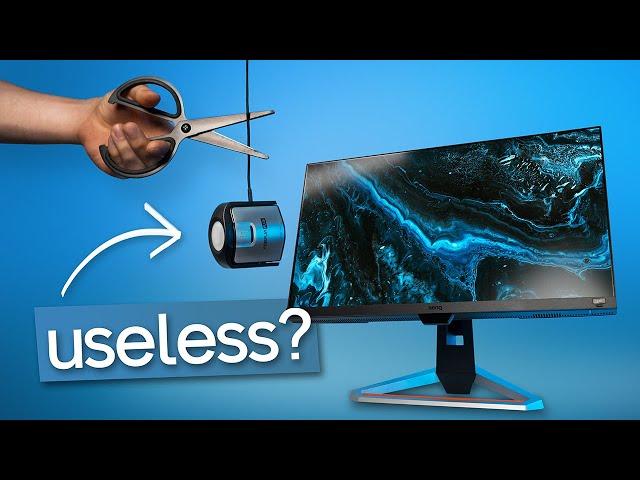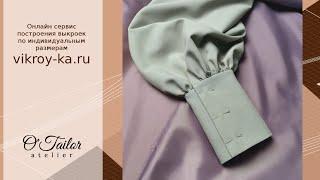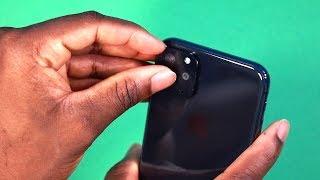
Can You Calibrate a Monitor WITHOUT a Colorimeter?
Комментарии:

your video has grey blacks
Ответить
Hey, I'm a little late to the party but you can also get a Wandfarbenmusterheft from Obi and then go onto their webpage and compare the colors shown in the Wandfarbenmusterheft with the equivalent on the webpage. You can then dial in the settings on your monitor to match the colors on the screen with those in the Wandfarbenmusterheft as close as possible. Of course this should be done in Daylight.
Ответить
Well, for the cheap and medium class monitors, adjusting anything, except the backlight, leads to loosing color resolution. This is very visible with color gradients and grey scales. Adjusting color temperature most likely will give you grey scale tracking errors, bigger and more visible than with the default settings. Also, you will loose color brightness steps. I guess, this is because adjusting is done digitaly, by modifying the input data, not by altering the actual panel voltages..., which I think is not so easy, given that the panel is probably not characterized and/or the manufacturer does not provide any data for such adjustment.
Regarding the colorimeters - they are a gimmick IMHO. Gloryfied 3 pixel cameras with primary color filters. Only spectrometer can give you meaningfull reading, especially for the modern monitors with all kinds of backlights and gamut "widenesses".

“That you’ll probably only use once.” Depends who you are and what you’re doing. Displays change as they age and need to be calibrated periodically as a result. This is why calibration software offers to remind you every few weeks or months. I do t do anything professionally with my displays, so I only recalibrate once a year. Every single one drifts a little bit during that year. CRTs, LCDs, and OLEDs. One of the first steps is setting the RGB balance, and none of those settings has ever landed back on the same settings I used the last time. It always changes a little. Will it matter to you? This of course depends on what you’re doing and why. Some professionals recalibrate at the start of each new job, even if that’s every day. Will it change much in a day? Not likely. But to some people, they’d rather start from a known point than waste time assuming something is right only to find out it wasn’t and have to redo stuff.
Ответить
How many people have the ability to accurately judge color accuracy with the naked eye? My estimate would be zero.
Ответить
what is wallpaper on monitor in background called
Ответить
crazy you got that monitor to be that accurate. Guess theres no need to buy super expensive factory calibrated monitors thats marketed for people who works with color critical media.
Ответить
Red bitte deutsch xD english hört sich hart scheiße an
Ответить
Now where's the tutorial of how to calibrate with a colorimeter? :D
Ответить
lol, das "bis zum nächsten Video" am Ende, kam sehr überraschend. Danke für die Tipps. Sehr gutes Video. Weiter so! :)
Ответить
Das "bis zum nächsten Video" hat mich erschrocken 😂
Ответить
That lux app you showed is made by a scammer, you can buy ad removal but in couple of days it starts showing ads again unless you remove app data and cache, talk about annoying, i use it to see if my plants get enough light
Ответить
You might be able to do the white point, but good luck on Gamma curve
Ответить
Any calibration process without proper measurement equipment is impossible.
Eye is NOT a proper measurement equipment. Not a spectrophotometer, not a colorimeter.

When you're measuring brightness on a monitor like that you have to do it more towards the centre of the screen. There was quie bad fall off at the corners and edges so I think if you'd gone a little further in you would have hit the brightness mark exactly.
Ответить
Is this Julian Krause 2.0?
Ответить
I also spend more than 200 USD on a prostitute, and I also only use her once. So no problem.
Ответить
me trying to calibrate my TFT LCD VA display ._.
Ответить
You can even use one of those RAL color wavers :D
Ответить
When we assume that a good Smartphone is already color calibrated, wouldn't that be a good way do visually compare it with your own monitor?
Ответить
lifehack: rent a colorimeter
Ответить
Interesting video, thanks for sharing.
Ответить
how about use CLTest? idk, how accurate im calibrate monitor with this software, but for eyes is so more comfortable...
Ответить
What's the point in doing proper color calibration, if you're going to surround the monitor with the RGBT lighting.
Ответить
The Nvidia color correction controls are useful especially since you can adjust gamma separately for each color (I was able to set Gamma for 3 different brightness levels using the brightness/contrast levels independently for each color). Unfortunately I use AMD now and AMD doesn't have anything that is equivalent or works as well as far as I can tell. I could download these correction curves from the graphics card using DispCal and use them as a profile, but again I can't find anything I can use this way with AMD. It is amazing when you get it looking like your monitor is just a portal to a different place.
Ответить
How do you use a colorimeter?
Ответить
Why calibrate it?
Ответить
I have a question what about in a display with HDR that mostly locks every settings to chance this
Ответить
Nah, I'm buying the colorimeter. My overthinking ass could never dial the colours in properly.
Ответить
why do you make these adjustment in the monitor instead of the OS? Windows even provides a "calibration" tool to do it by eye.
Ответить
I prefer the windows built in gamma calibration settings. The pattern is very clear and you get to run a slider back and forth until the patterns merge.
Ответить
a long time ago before phone apps I used my camera's custom white balance feature to try to manually dial in the white point. Now I use an android app called LightSpectrumEvo which reads the brightness and white point in real time.
Ответить
a collection of misleading informations ... Already the fact you let think people that a calbration probe is used only once is quite embarassing...
Don't follow anything explained here for a professional workflow.

The white color of the paper depends on the lighting in the room, its color temperature and its CRI value! So relying on this will supposedly result in success, but it is nowhere near guaranteed!
Ответить
In EU you can buy a 500 EUR calibration tool, use it once and send it back to get a full refund within 14 days.
Ответить
Take a look at Atrise Lutcurve (if you use windows). I used to use this on my work PC before I bought a Spyder X.
Ответить
I would argue that the short answer to the question "Can You Calibrate a Monitor WITHOUT a Colorimeter?" is "no". A bit of a scholastic point maybe, but that's because of the verb "calibrate". Try to calibrate your micrometer (measurement instrument for measuring length) by eye and using simple "references". Your Din/ISO quality certification inspector will give you a total fail for that.
Left implicit, there are other problems with this approach. "Daylight" varies a lot in colour temperature across seasons, geographic latitude, and orientation towards the sun. Look at photos taken in the golden hour (sunrise/sunset) when the direct sunlight is rather or very warm and in these shots, look in areas of shade - these are extremely blue. So if your editing studio is facing North ( in the Northern hemisphere), then you are in the blue zone of shade where the blueishness varies during the day. Painters (the artists) prefer an atelier with such Northern light. So a visual "~calibration" in such light really depends on these factors and you understanding what you are doing. For the people in the Southern hemisphere, London-Amsterdam-Berlin is about 52 degrees North - compare Ushuaia 54.8S, Bluff-NZ 46.6S, Dunedin 45.9S, Hobart T/Au) 42.9S. Higher latitudes will make the light's colour temperature lower (and we call that warmer), but an overcast sky diffuses the light to a point that it becomes more neutral - clouds remove the dispersion effect of the golden hour.
While we arguably can do a pretty good job with the naked eye, or may use a monitor calibration device, this leaves printer/ink/paper calibration and e.g. projector calibration. You may argue that your professional paper brand gives you a colour profile for your printer (but it makes assumptions about the ink). If you print via a professional print house, then they may have their colour correction profile that you can apply to your proofing but this assumes a monitor calibrated to neutral and if you want to visually ballpark monitor calibration, send images to the print house in order to calibrate between monitor and prints - different papers have different profiles and even different batches of the "same" paper may have different profiles.
I would argue, when you work as a pro (earn your income from photography and have tax-deducible expenses) then buy a calibration device that can calibrate your entire tool suite. If you are printing a lot yourself with "fine art" ambitions and prices, then invest in a professional calibration tool. The whole point is between your monitor and prints that you want "What You See on the Monitor Is What You Get from the printer". Or, if you are a total amateur, say collector of bird images, and want to print your shots, then relative to your many thousands of Western currencies spent on a fast 600 or 800 lens, the calibration device is laughably cheap.
As you discuss monitor calibration, don't forget in this mirrorless age, that your camera may have viewfinder calibration setting options as well. And as your camera can generate SOOC JPEG images, it may have picture control profiles that define how the raw to JPEG conversion is done - someth8ing you may want to calibrate too and potentially define your own profile for that (between different camera models you may need different profiles even from the same brand).
The elephant in the room then is that many people are colour blind (in my language we call them, that, "colour weak") but sill shoot in colour. Famous - if you like - US photographer Joel Grimes self-admittedly is one. He works in a generally desaturated palette, and you would assume that "colour" may not be very important to him, but I presume he is very finicky about his version of WYSIWYG.
The other elephant in the room is that some people see the humanly visible spectrum in 4 bands, not 3. All of colour photography is on 3 bands (red, green, blue) but these 4-banders may see colours differently. The anatomy of the brain is on the X chromosome (which is not the same as intelligence, character, personality) and men only have this from their mothers -well, as most colour weak people are men who see in 2 spectral colour bands, my guess is that the anatomy of the cones in the retina is also on the X chromosome and the women that see in 4 bands may have 2 bands on each chromosome (all sons will be colour weak), or three on one and two on the other (some sons will be colour weak). To their daughters then the biological father's genes become an important factor. A colour weak father passes his weakness on to all his daughters.
Genetics aside, if you are colour weak and never decided to go "black and white only", then you may want a calibration device, if only to get proper colours for your family and clients that do see in 3 bands.
Finally, between the monitor and the prints, you have to understand your monitor's maximum colour space and your printer/ink/paper combination's. You may be able to print a larger colour space than your monitor can render and now you really need (a) in-depth training and (b) serious calibration. My EIZO monitor's colour space is at least 100% Adobe RGB, which is more than sRGB that most monitors can render. Note here that colour space without contrast envelope (dynamic range available to one image) is meaningless. "Dynamic contrast" is best switched off in still image editing. This is a trick in backlighting LCD monitors where LEDs behind the LCD are made brighter or dimmer, but the LEDs light a region that is much larger than a single pixel. While you may be able to switch this off, also note there are monitors that fake higher bits per channel by making subpixels flicker. In that sense an 8 BPC monitor may be 6+2, or a 10 BPC one may be 8+2. My EIZO does 10 BPC without that and does not have problems with "difficult" colours. Not to brag, but if eyeballing for calibration is not good enough, take this all into account.

calibrate a monitor without a good colorimeter ? good luck with that ...
Ответить
The colorimeter is not usable once. But periodically
Ответить
Shower thought: Take a color on the screen. Print it. Now match both colors.
Idk if that'll actually work. Was just thinking

This is complete nonsense, waste of time. Use proper SW and calibration device. There is no way to adjust the screen using your eyes (unless you LCD screen is perfect). Only thing you can adjust this way is color of 100% white, but nothing in the middle or dark tones.
Ответить
Optimizing for a D65 (daylight) white point is a bad idea. Our eyes (and therefore also digital cameras) adapt to the color temperature of the environment. So things that look white in daylight will look very blueish in artificial light, and things that look white in artificial light will look very yellowish in daylight. The correct solution is not to use a fixed white point but to have a display that has a light temperature sensor and automatically adjusts the color temperature of the screen to the environmental lighting, like a camera or the human eye. Apple actually does do this. They call it "True Tone" (because Apple always invents names for things).
Ответить
Awesome tutorial! Thank you very much!
Ответить
I usually set the colors from my galaxy S phone to Natural and then use it as a reference I'll try to match in the monitor. Works pretty well, those phone's screen are, more often than not, the most accurate and best quality screen in the buiding.
Ответить
pls name of the desktop coverr from the first scene
Ответить
have you seen how many white papers there are? Sorry but you're wrong also you said by eye yet you used your phone ?????? FAIL
Ответить
Nice demonstration. However, simply stated, for the average person who does not have an "EYE" for evaluating a screen, manual color calibration is a complete waste of time.
Ответить
Once you buy an Eizo monitor, paint the room in neutral colors, use full spectrum lighting and send the material to be printed, they will make sure that everything is in other colors than what you sent!
Ответить
I got a Calibrite and it make me furious... do not buy one... i literally doesn't work... it can't even make one monitor look correct let alone more than one... no matter what I told it to do it would make my whites look yellow and the screen dark and milky... they literally should not even be in business.
Ответить

























